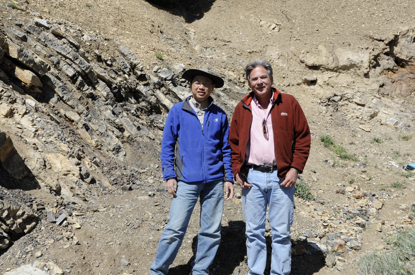Four hundred and forty-five million years ago, Earth experienced a short-lived glaciation which lasted about 2 million years. During the advance and retreat of the Late Ordovician glaciation, the mass extinction occurred which resulted in the disappearance of 85% marine species. But what caused the Late Ordovician glaciation?
A new joint study by a team led by Ann Pearson at Harvard University in Cambridge, USA and a team led by SHEN Yanan at University of Science and Technology of China (USTC) suggests that expanded eukaryotic algal production during the Late Katian may have resulted in higher export efficiency and burial of organic carbon, drawing down atmospheric CO2 and triggering the Late Ordovician glaciation. The study was just published online ahead of print in Nature Geoscience on June 12th.
To better understand the cause(s) of the Late Ordovician glaciation, the team from Harvard and USTC measured carbon and nitrogen isotopes from the Vinini Creek section in the Roberts Mountains, Nevada. The Vinini Creek section is within a bulldozer-excavated trench and provides a most complete and expanded succession through the extinction interval. Realizing its potential as a rich data source for understanding climate dynamics before and during the mass extinction, SHEN contacted Stanley C. Finney from California State University at Long Beach (CSULB) for sampling. Stanley Finney is a leading expert in the Late Ordovician biostratigraphy and is also a co-author of the paper. In fact, it was Finney who excavated the Vinini Creek section by a bulldozer more than 20 years ago. The Vinini Creek section was carefully measured, described in detail, and sampled in high resolution.

SHEN Yanan and Stan Finney/ Photo from SHEN Yanan
In SHEN’s lab at USTC, Total of Organic Carbon (TOC) content, C-isotopic compositions of carbonate and organic carbon, and nitrogen isotopic compositions were measured. "We were surprised by the isotopic data and extraordinary high TOC contents of up to 21% in shales deposited right before the Late Ordovician glaciation", says SHEN. The high TOC contents must have accumulated under anoxic conditions during a sea-level highstand, according to SHEN and Finney. In Pearson’s lab at Harvard, nitrogen isotopic compositions of porphyrins were analyzed. They discovered the significant differences of N-isotopic values between prophyrin and bulk samples. The new finding suggests increased eukaryotic export and burial of organic carbon, ultimately drawing down of atmospheric CO2 and leading to the Late Ordovician glaciation.
"We are excited by the results. However, we are far away from fully understanding how the Earth transformed into icehouse in the Late Ordovician and how climate changes may have driven the mass extinction", SHEN adds.
(edited by LYU Jinghao ,USTC News Center)